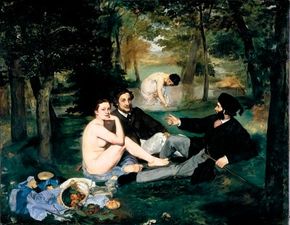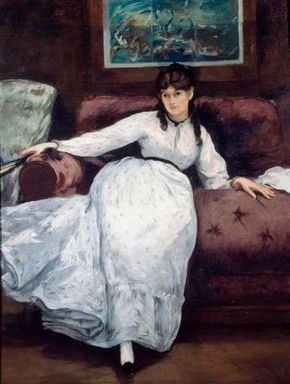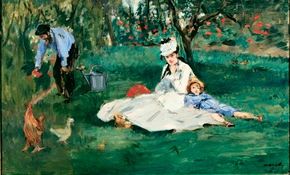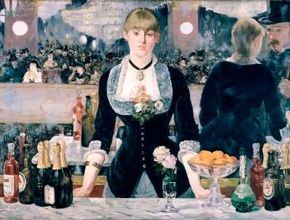Edouard Manet (1832-83) was a crucial figure in the rise of the Impressionist movement. In 1863 Manet -- who had already received favorable critical notice -- entered work in the Salon des Refusés, but his painting Le Déjeuner sur l'Herbe drew a savage response from the critics. Going against contemporary ideas of art, Manet brought the modernist point of view into direct conflict with conventional standards, and his intentions were misunderstood.
Edouard Manet's resistance to the critical onslaught attracted the attention of younger artists. Three of the artists, Claude Monet, Pierre-Auguste Renoir, and Frédéric Bazille, had met in 1861, and two others, Paul Cézanne and Camille Pissarro, both veterans of the Salon de Refusés and advocates of painting outdoors, also joined in the conversation. As a group, they exchanged ideas and debated issues. Edouard Manet welcomed the opinions and the support of this informal circle, and he introduced his friends to other aspiring painters. Eventually this group became known as the Impressionists.
Advertisement
Click on the links below to learn about some of Edouard Manet's most famous Impressionist paintings.
- Le Déjeuner sur l'Herbe: Edouard Manet's Le Déjeuner sur l'Herbe was roundly attacked by critics upon its showing in 1863. Learn about Manet's Le Déjeuner sur l'Herbe, which helped launch the Impressionist movement.
- Le Repose (Portrait of Berthe Morisot): Le Repose by Edouard Manet is a portrait of fellow Impressionist painter Berthe Morisot. Learn about Le Repose (Portrait of Berthe Morisot).
- The Monet Family in their Garden at Argenteuil: Edouard Manet was close friends with Claude Monet, and used the artist's family as the subject of this painting. Learn about The Monet Family in their Garden at Argentuil, which Manet painted in 1874.
- Music in the Tuileries Garden: Music in the Tuileries Garden by Edouard Manet demonstrates Manet's interest in middle-class life. Read about Music in the Tuileries Garden, which includes a portrait of the poet Charles-Pierre Baudelaire.
- A Bar at the Folies Bergere: Edouard Manet's A Bar at the Folies Bergere is noted for its psychological complexity. Learn about A Bar at the Folies Bergere, one of Manet's undisputed masterpieces.
On the next page, see a detailed image of Edouard Manet's Le Déjeuner sur l'Herbe.For more on Impressionist paintings, artists, and art history, see:
Advertisement




